A flying submarine is a craft able both to fly or travel under water.Several designs have thought over the decades.It's also a popular craft,used mostly the 1960's tv series *Voyage to the Bottom of the Sea and Marvel Comics Prince Namor ,otherwise The Sub-Mariner (Marvel Comics) -mainly featured in Invaders(Maveric comics) of the 1970's

The Soviet Union tried to develop a flying submarine during World War II. The design could have operated at 150 knots in the air and 3 knots in the water. Metal plates sealed the engines shut. The design never "got off the ground."<ref>Russian Flying Submarine Unknown, Date Unknown (accessed 21 January 2007)</ref>
In 1961 Donald Reid designed and built a single-seat craft (32.83 ft length) capable of flight and underwater movement. A 65 hp (48 kW) engine mounted on a pylon provided propulsion for flight; a 1 hp electric motor in the tail provided underwater propulsion. The pilot used an aqualung for breathing underwater. The first full cycle flight [underwater at 6.5 feet (2 m.) depth, airborne at 33 ft. (10 m.) altitude] was demonstrated on 9 June 1964.<ref>http://www.aerofiles.com/_ra.html see Reid, Ashbury Park NJ (subheading)</ref>
The U.S. Navy and Flying Submarines OK … UFOs go in and out of water. Why? … We really don’t know. All we have is speculation. Of course, there is no reason for us to want to have a craft that can emulate them … right? I mean aircraft do aircraft things and submarines do their thing … what need for yet another expensive piece of machinery for warfare? Avoidance of radar and visual sightings? Well it seems that not only was it thought of, but the idea was funded (see news clip) as well. Think the Navy might be interested in those things that don’t exist???? MAYBE …
AP Wire photo
Navy weighs sub-plane
This drawing by the Convair Division of General Dynamics Corp. In San Diego, Calif., shows how a proposed combination seaplane-submarine would appear under water. The company is studying the feasibility of such a craft under a $36,000 Navy contract. The craft would be submerged by flooding of the wing, tail and hull compartments. It would travel 5 miles an hour under water, powered by batteries.
Dreaming in earnest
Flying sub idea studied[]
WASHINGTON (AP) The Navy wants to develop a flying submarine.
The idea is for a smallish craft capable of flying to and submerging for operations in relatively closed waters.
In event of war with Russia, for instance, it would be highly difficult if not impossible for a conventional surface vessel or submarine to penetrate the Baltic or the Black Sea. A flying sub might do it. It might even operate in the Caspian Sea.
The thought of a flying submarine is one, which has been kicked around in the Navy off and on for a good many years. But this time it has gone further than talk. A contract for analytical and design studies has been given to the Convair and Electric Boat Divisions of General Dynamics Corp.
The $36,000 contract sets no time limit. But the Navy says the study should be completed by next June.
Any actual construction--if it ever comes off--might well be many years in the future.
Eugene H. Handler, an aircraft hydrodynamics engineer with the Bureau of Naval Weapons; discusses the problems in an article in a recent issue of the magazine "U.S. Naval Institute Proceedings," a semiofficial publication.
His conclusion:
“The development of a practical flying submarine prototype will be both complex and laborious, but the potential returns are substantial and valuable.
Consequently the concept of such a vehicle merits careful engineering examination rather than the overly optimistic accolade of a few imaginative enthusiasts and the simultaneous cold shoulder denial of the hard headed realist."
In his article, Handler writes of a possible craft with an operating depth of 25 to 75 feet, a submerged speed of five to 10 knots for four to 10 hours, airspeed of 150 to 225 knots for two or three hours and a payload of 500 to 1,500 pounds. He says it is believed these characteristics can be attained within a vehicle weighing 12,000 to 15,000 pounds.
The Japanese used midget submarines, though not with particular success, in combination with their air attack on .
The Italians carred (sic) out a highly damaging raid in that same month with midget submarines against British battleships in .the Mediterranean harbor of Alexandria.
Those World War II craft, however, provided little hope for anything except a suicide mission.
A little flying sub might carry out its mission and take its crew back.
From Naval Institute Proceedings
THE FLYING SUBMARINE
During World War II, midget submarines were used extensively and often quite successfully by the British, Italian, German, and Japanese navies. These craft ranged from miniaturized versions of conventional submarines to modified torpedoes fitted with seats and controls for a two-man crew.
Because their primary mission was the destruction of ships in harbors, most of these craft had a relatively slow operating speed. Their other major limitation was a lack of range, and it was usually necessary to tow or carry them most of the distance to their objective and then retrieve them after their mission was accomplished.
Often, because of these limitations and the difficulty of recovery in enemy-controlled waters, the midget submarines were abandoned after accomplishment of their mission and the crews were either lost or captured. Thus, a report on the success (or failure) of the mission was not relayed back to the command in time to capitalize on the submarines' operation. This situation occurred on 19 December 1941, when three Italian "human torpedoes" seriously damaged the British battleships Queen Elizabeth and Valiant in Alexandria harbor. Both battleships were incapacitated for many months, but it was possible to keep them on even keels, and enemy intelligence, primarily from air reconnaissance, did not immediately learn of their complete incapacity.
The most needed improvements for the midget submarine appear to be increases in cruise speed and radius so that the submarine is able to return from missions without immediate assistance from other craft. The very low speeds required during attack were usually adequate. In fact, low speed and high maneuverability coupled with the ability to operate with the utmost of stealth are the prerequisites of a successful midget.
The usefulness of a weapon depends upon the type of warfare needed to combat the enemy. In the event of war, the Soviet Fleet is intended to destroy lines of communication and supply to our allies and to attack our territory with submarine-launched missiles. Our Navy's primary tasks are to protect our lines of communication and supply, to protect the country from enemy attack, to provide carrier-based striking forces for use against attacks on the enemy homeland, and to destroy enemy shipping. There is, however, a tremendous amount of shipping in the Soviet-dominated Baltic Sea, the essentially land-locked Black Sea, the Sea of Azov, and the truly inland Caspian Sea. These waters are safe from the depredations of conventional surface ships and submarines. It has been demonstrated repeatedly that a warship can only rarely penetrate the Dardanelles, Bosporus, or Kattegat if held by an enemy, and there is no reason to believe that the situation would be changed in a future conflict. If the Soviets believe the extremely dense shipping in the above bodies of water to be safe from underwater attack, then they will have no ASW surveillance or equipment in these areas.
Since it is probable that no conventional undersea craft would be able to enter inland waters such as those previously mentioned, it is necessary to develop a new concept of weapons delivery. It has been suggested that large seaplanes could carry midget submarines to their destination and later return to take them on board for return to friendly territory. However, the inherent disadvantages make this method impractical. A seaplane capable of carrying a small submarine would probably weigh a half million pounds or more, be prohibitively expensive, and be a conspicuous and desirable target for the enemy's air-defense systems. The possibility of success in retrieving the submarine would appear to be hopelessly small.
An air-towed midget submarine has many attractive features for such a role: detachable aerodynamic surfaces could be dropped after alighting, leaving a conventional small submarine to carry out an operation; there would be no need for in-flight power; and the tow plane could carry out its own diversion mission to protect the submarine. Such a weapon would have one serious disadvantage: being expendable, the undersea craft's crew would be faced with the demoralizing propositions of surrender or attempting to go through aroused enemy lines to reach friendly soil. If the wings were retained, the consideration could be given to a second flight by the tow plane in an effort to pick up the submarine; but again, the chance of success would appear to be slight.
==true flying submarine==
Another alternative, a true flying submarine, offers more promise than either of the above methods. It could fly from a favorable location to its destination at minimum altitude to avoid detection by radar. At the completion of its underwater mission it could travel as a submersible to a location best suited for takeoff, become airborne and return to base.
There are many alternate approaches to the design of a flying submarine, as has been made evident by the numerous proposals of recent years by reputable engineers. The basic mission and the requirement for compatibility of aerodynamic and hydrodynamic characteristics require that the performance of practical vehicles be rigorously limited to minimum aircraft and submarine capabilities. Size, speed in air and water, submergence depth, and payload must all be realistically established prior to serious consideration of any preliminary design. Each capability taken separately is extremely modest. It is the combination of these capabilities into a single craft, which provides a remarkable vehicle.
The preceding discussion of proposed useful missions envisions an operating depth of about 25 to 75 feet, submerged speed of five to ten knots for four to ten hours, airspeed of 150 to 225 knots for two to three hours, and a payload of 500 to 1,500 pounds. It is believed these characteristics can be attained within, a vehicle weighing only 12,000 to 15,000 pounds. The Bureau of Naval Weapons has recently awarded a contract to the Convair and Electric Boat Divisions of General Dynamics for analytical and design studies of the essential components and operational aspects of such a vehicle.
When an operating vehicle has been developed capable of achieving these moderate goals it will then be time to consider a more versatile successor.
There are obviously basic design problems involved in any concept of a flying submarine no matter how modest its capabilities. The basic problem is suggested by the very term "flying submarine." The vehicle's density must be comparable with that of conventional aircraft of roughly equivalent performance, yet must be susceptible of increase to that required for operation in its alternate medium, water, in order to submerge, cruise, and hover beneath the surface with minimum power. The cockpit, engines, instrumentation, fuel, batteries or electrical power-generating fuel cells, electric motor, etc., must all be watertight. All other spaces would be floodable to minimize the inherent buoyancy, and consequently need not withstand the static pressures encountered during the vehicle's submerged operation.
The aircraft engine requires only moderate modification for effective waterproofing while retaining a self-starting capability after completion of the submerged phase of the mission. Both intakes and exhausts would be placed above the static water line. The intakes would also be located out of the spray pattern of the planing hull or hydro-skis, as is the case with any conventional seaplane. Electric torpedo powerplants would furnish extensive background datum for the alternate propulsion system. The battery-charging equipment would be far less elaborate than in conventional submarines, if batteries were chosen in preference to fuel cells. With the latter, no charging equipment would be necessary.
There remain numerous problems inherent in the various systems and components required in the flying submarine. Most, if not all, appear to be capable of solution through the application of existing techniques and engineering practices. These problems can generally be divided into six classifications: buoyancy, stability and control in both media, vehicle habitability and crew survival, structural considerations, availability of equipment, and the parameters of design and operation.
The first of these areas, buoyancy, its directly related yet opposed requirement for high density, covers numerous items such as ballast tanks and their flooding and purging systems, and fore-and-aft fuel transfer to maintain longitudinal stability in flight and in the sea. The second, stability and control, requires investigation of a single system to operate in both media; the best aerodynamic / hydrodynamic configuration--i.e., a comparison of the merits of a conventional arrangement, delta wing with and without tail, canard, cruciform, etc.; take-off and alighting technique conventional versus vertical; and placement of surfaces for satisfactory maneuvering and diving from the surfaced condition. Habitability and survival problems require primarily the combination of systems already in existence in submarines, high altitude aircraft, and man-carrying satellites, with emphasis upon canopy design, provision of air supply and purification during submerged operations, and emergency escape for both submerged and in-flight conditions. Structural considerations require the determination of dynamic loads in flight and submerged conditions as well as the static loads imposed by deep submergence. Materials must be selected to avoid damage resulting from corrosion and galvanic action. The equipment associated with the aeronautical, electrical, naval and associated industries must be surveyed to establish the availability of items required in the prototype submarine as well as to list those components requiring development for this unique craft of design and operational parameters requires the derivation of interrelationships between equipment weight; air cruising speed and range; water cruising speed, range and maximum depth, and vehicle weight.
The development of a practical flying submarine prototype will be both complex and laborious, but the potential returns are substantial and valuable. Consequently the concept of such a vehicle merits careful engineering examination rather than the overly optimistic accolade of a few imaginative enthusiasts and the simultaneous cold-shoulder denial of the hard-headed realist.
This reference: U. S. Naval Institute Proceedings, September 1964, “THE FLYING SUBMARINE”, pp. 144-146, by Eugene H. Handler, Aircraft Hydrodynamics Engineer, Airframe Design Division, Bureau of Naval Weapons
==Lokheed Martin Cormorant==[]
The US Navy is reportedly looking at the Lockheed Martin Cormorant, a drone aircraft launched from a submarine. On launching it floats to the surface and after flight it is retrieved from the water surface; it cannot travel directedly underwater.
==Darpa==[]
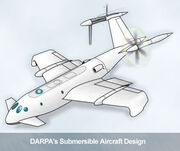
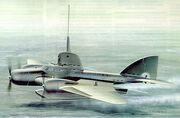
DARPA wants a submarine that can travel 1,850km in the air, 185km on the water's surface or 22km underwater, and do it in less than 8 hrs.
This reminds me of the already debunked sub launched F-15 taking off out of the water like a sub launched ICBM. However this is not nearly as sexy as that, nope - this is an 8 passenger craft for inserting small cladestine teams into a hot point
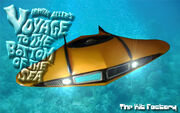
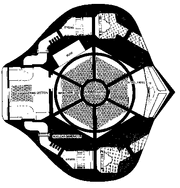
==Flying subs in fiction==[]
A wide variety of flying submersible craft can be found in X-COM: Terror from the Deep.
A flying submarine was a feature in:
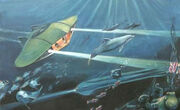
*Voyage to the Bottom of the Sea (TV series)



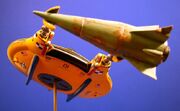


*The Japanese Toho Studios film Atragon.
*Sky Captain and the World of Tomorrow
*The Incredibles
==References==
==External links==
* The U.S. Navy and Flying Submarines
* Reid Flying Submarine
* «The Flying Submarine: The Story of the Invention of the Reid Flying Submarine, RFS-1» by Bruce Reid ISBN 0788431366
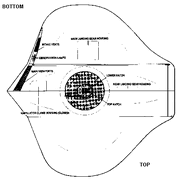
Template:WWII-stub
de:Fliegendes U-Boot
ru:Летающая подводная лодка
